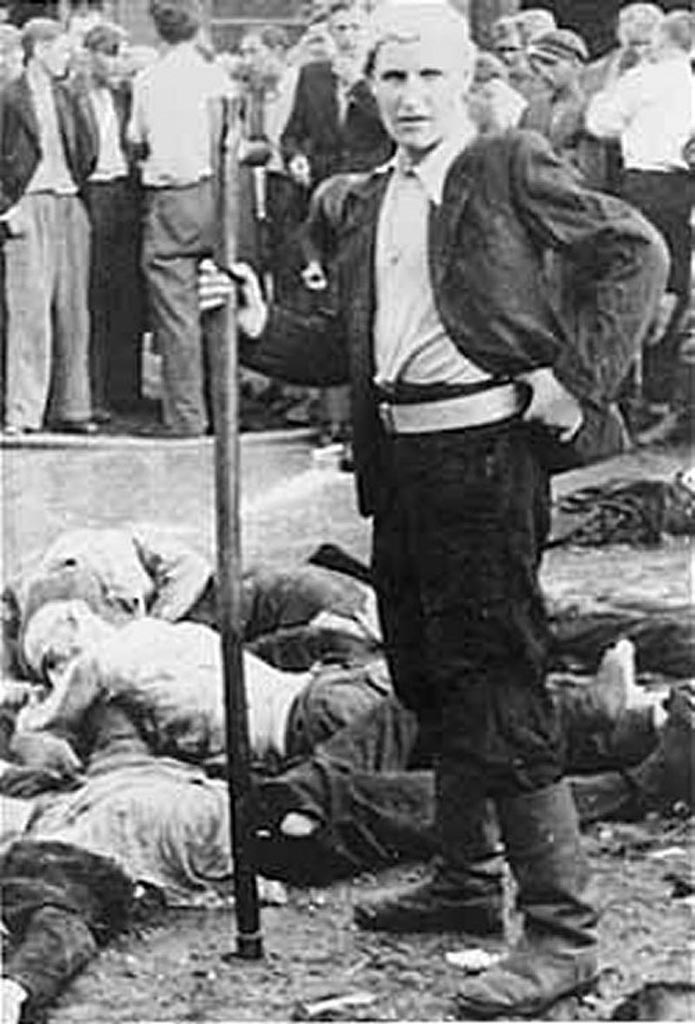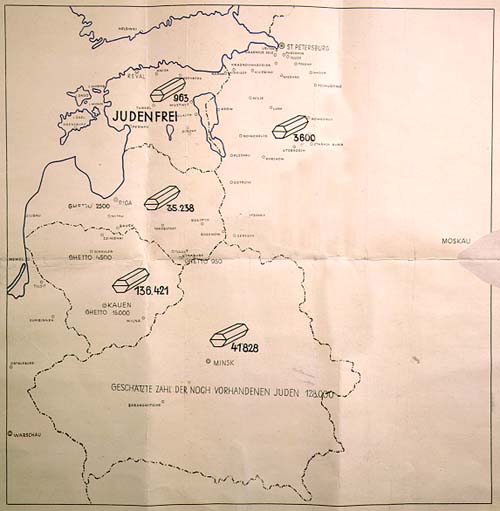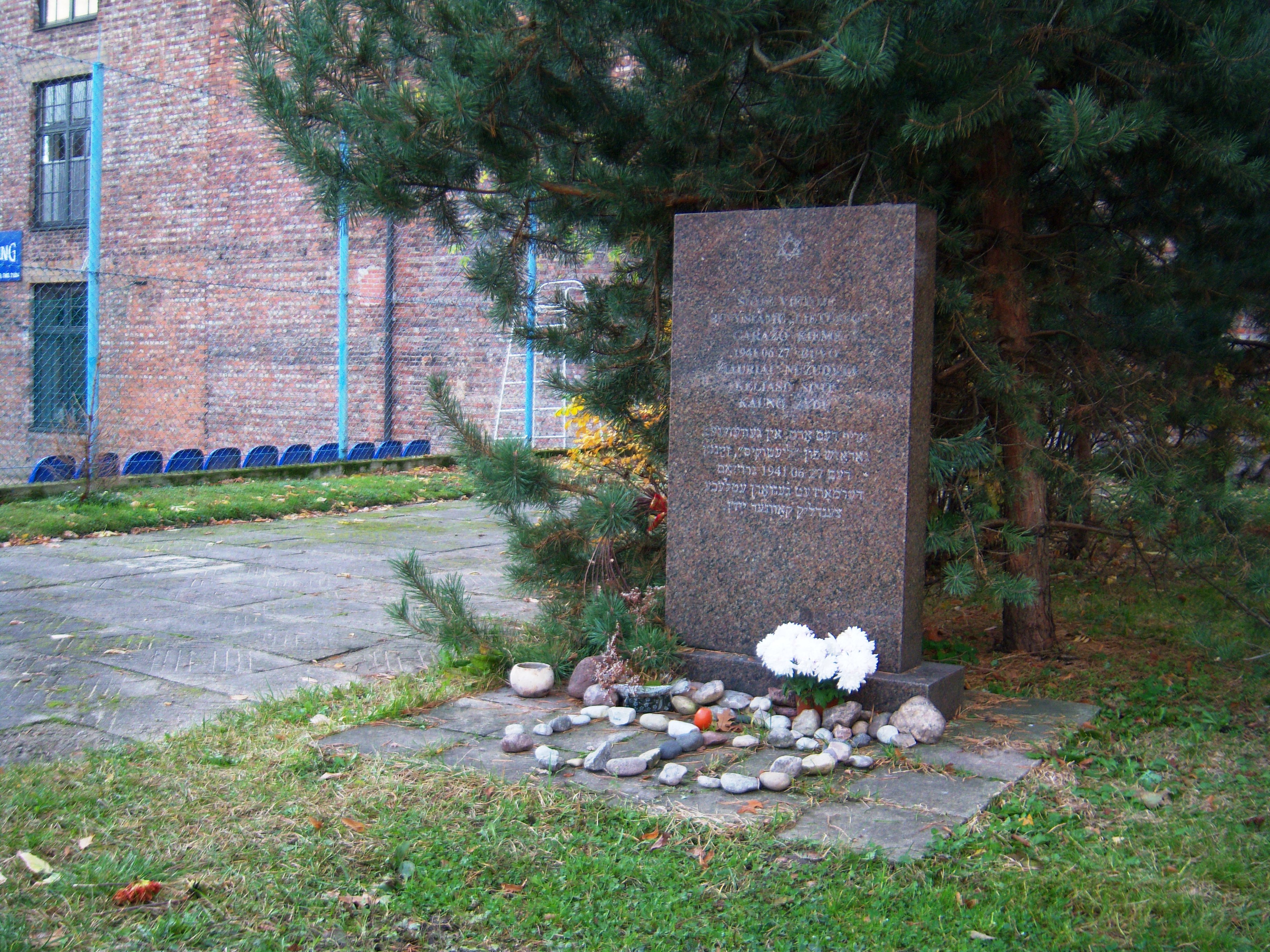Kaunas pogrom on:
[Wikipedia]
[Google]
[Amazon]
 The Kaunas pogrom was a massacre of
The Kaunas pogrom was a massacre of
 The Lithuanian Activist Front (LAF), a far-right underground organisation operating inside Soviet Lithuania, took control of the city and much of the Lithuanian countryside on the evening of 23 June 1941. Nazi SS
The Lithuanian Activist Front (LAF), a far-right underground organisation operating inside Soviet Lithuania, took control of the city and much of the Lithuanian countryside on the evening of 23 June 1941. Nazi SS
 Starting on 25 June, Nazi-organized units attacked Jewish civilians in Slobodka (
Starting on 25 June, Nazi-organized units attacked Jewish civilians in Slobodka (
 There is controversy over who was primarily responsible for initiating the massacres: local Lithuanians or Nazi officials.
Memoirs of witnesses of the event say that German Nazi soldiers in uniforms participated in Lietūkis' sadistic tortures and massacres, but were also accompanied by some Lithuanians who were recently freed from the Kaunas Prison.
Some Lithuanians cite
There is controversy over who was primarily responsible for initiating the massacres: local Lithuanians or Nazi officials.
Memoirs of witnesses of the event say that German Nazi soldiers in uniforms participated in Lietūkis' sadistic tortures and massacres, but were also accompanied by some Lithuanians who were recently freed from the Kaunas Prison.
Some Lithuanians cite
 The Kaunas pogrom was a massacre of
The Kaunas pogrom was a massacre of Jews
Jews ( he, יְהוּדִים, , ) or Jewish people are an ethnoreligious group and nation originating from the Israelites Israelite origins and kingdom: "The first act in the long drama of Jewish history is the age of the Israelites""The ...
living in Kaunas
Kaunas (; ; also see other names) is the second-largest city in Lithuania after Vilnius and an important centre of Lithuanian economic, academic, and cultural life. Kaunas was the largest city and the centre of a county in the Duchy of Traka ...
, Lithuania
Lithuania (; lt, Lietuva ), officially the Republic of Lithuania ( lt, Lietuvos Respublika, links=no ), is a country in the Baltic region of Europe. It is one of three Baltic states and lies on the eastern shore of the Baltic Sea. Lithuania ...
, that took place on 25–29 June 1941; the first days of Operation Barbarossa
Operation Barbarossa (german: link=no, Unternehmen Barbarossa; ) was the invasion of the Soviet Union by Nazi Germany and many of its Axis allies, starting on Sunday, 22 June 1941, during the Second World War. The operation, code-named afte ...
and the Nazi occupation of Lithuania. The most infamous incident occurred at the garage of NKVD
The People's Commissariat for Internal Affairs (russian: Наро́дный комиссариа́т вну́тренних дел, Naródnyy komissariát vnútrennikh del, ), abbreviated NKVD ( ), was the interior ministry of the Soviet Union.
...
Kaunas section, a nationalized garage of Lietūkis, an event known as the Lietūkis Garage Massacre. There several dozen Jewish men, allegedly associates of NKVD, were publicly tortured and executed on 27 June in front of a crowd of Lithuanian men, women and children. The incident was documented by a German soldier who photographed the event as a man, nicknamed the "Death Dealer", beat each man to death with a metal bar. After June, systematic executions took place at various forts of the Kaunas Fortress, especially the Seventh
Seventh is the ordinal form of the number seven.
Seventh may refer to:
* Seventh Amendment to the United States Constitution
* A fraction (mathematics), , equal to one of seven equal parts
Film and television
*"The Seventh", a second-season e ...
and Ninth Fort
The Ninth Fort ( lt, Devintas Fortas) is a stronghold in the northern part of Šilainiai elderate, Kaunas, Lithuania. It is a part of the Kaunas Fortress, which was constructed in the late 19th century. During the occupation of Kaunas and the ...
.
Background
 The Lithuanian Activist Front (LAF), a far-right underground organisation operating inside Soviet Lithuania, took control of the city and much of the Lithuanian countryside on the evening of 23 June 1941. Nazi SS
The Lithuanian Activist Front (LAF), a far-right underground organisation operating inside Soviet Lithuania, took control of the city and much of the Lithuanian countryside on the evening of 23 June 1941. Nazi SS Brigadeführer
''Brigadeführer'' (, ) was a paramilitary rank of the Nazi Party (NSDAP) that was used between the years of 1932 to 1945. It was mainly known for its use as an SS rank. As an SA rank, it was used after briefly being known as ''Untergruppenf ...
Franz Walter Stahlecker
Franz Walter Stahlecker (10 October 1900 – 23 March 1942) was commander of the SS security forces (''Sicherheitspolizei'' (SiPo) and the ''Sicherheitsdienst'' (SD) for the ''Reichskommissariat Ostland'' in 1941–42. Stahlecker commanded ''Ein ...
arrived in Kaunas on the morning of 25 June. He visited the headquarters of the Lithuanian Security Police
The Lithuanian Security Police (LSP), also known as Saugumas ( lt, Saugumo policija), was a local police force that operated in German-occupied Lithuania from 1941 to 1944, in collaboration with the occupational authorities. Collaborating with th ...
and delivered a long anti-Semitic speech encouraging Lithuanians to solve the "Jewish problem". According to Stahlecker's report of 15 October, local Lithuanians were not enthusiastic about the pogrom
A pogrom () is a violent riot incited with the aim of massacring or expelling an ethnic or religious group, particularly Jews. The term entered the English language from Russian to describe 19th- and 20th-century attacks on Jews in the Russian ...
and so he had to use Algirdas Klimaitis and his men. Klimaitis controlled a paramilitary unit of approximately 600 men that was organized in Tilsit
Sovetsk (russian: Сове́тск; german: Tilsit; Old Prussian: ''Tilzi''; lt, Tilžė; pl, Tylża) is a town in Kaliningrad Oblast, Russia, located on the south bank of the Neman River which forms the border with Lithuania.
Geography
S ...
by SD and was not subordinated to the LAF.
Massacre
 Starting on 25 June, Nazi-organized units attacked Jewish civilians in Slobodka (
Starting on 25 June, Nazi-organized units attacked Jewish civilians in Slobodka (Vilijampolė
Vilijampolė is a neighborhood in the city of Kaunas, Lithuania, located on the right bank of the Neris River and the Nemunas River, near their confluence. Part of a larger which consists of Vilijampolė, , , and neighorhoods, and covers 1,720 h ...
), the Jewish suburb of Kaunas that hosted the world-famous Slabodka yeshiva Slabodka yeshiva may refer to:
* Hebron Yeshiva, a branch of the Slabodka Yeshiva in Hebron, relocated afterward to Jerusalem
* Slabodka yeshiva (Bnei Brak), a branch of the Slabodka yeshiva in Bnei Brak
* Yeshivas Knesses Yisrael (Slabodka)
Ye ...
. According to Rabbi Ephraim Oshry, there were Germans present on the bridge to Slobodka, but it was the Lithuanian volunteers who killed the Jews. The rabbi of Slobodka, Rav Zalman Osovsky, was tied hand and foot to a chair, "then his head was laid upon an open volume of '' gemora'' (volume of the Talmud) and hey
Hey or Hey! may refer to:
Music
* Hey (band), a Polish rock band
Albums
* ''Hey'' (Andreas Bourani album) or the title song (see below), 2014
* ''Hey!'' (Julio Iglesias album) or the title song, 1980
* ''Hey!'' (Jullie album) or the title ...
sawed his head off", after which they murdered his wife and son. His head was placed in a window of the residence, bearing a sign: "This is what we'll do to all the Jews."
As of 28 June 1941, according to Stahlecker, 3,800 people had been killed in Kaunas and a further 1,200 in other towns in the immediate region. Some believe Stahlecker exaggerated his murder tally.
Controversy
Franz Walter Stahlecker
Franz Walter Stahlecker (10 October 1900 – 23 March 1942) was commander of the SS security forces (''Sicherheitspolizei'' (SiPo) and the ''Sicherheitsdienst'' (SD) for the ''Reichskommissariat Ostland'' in 1941–42. Stahlecker commanded ''Ein ...
's report of 15 October to Heinrich Himmler
Heinrich Luitpold Himmler (; 7 October 1900 – 23 May 1945) was of the (Protection Squadron; SS), and a leading member of the Nazi Party of Germany. Himmler was one of the most powerful men in Nazi Germany and a main architect of th ...
. Stahlecker wrote that he had succeeded in covering up actions of the '' Vorkommando'' (German vanguard unit) and made it look like an initiative of the local population.
Other authors claim that massacres began even before the Germans arrived. They point out that executions took place in the countryside and not just in the city of Kaunas. Photography experts have suggested that many pictures from the Kaunas pogrom might have been falsified by gluing multiple pictures into one because there are many discrepancies in the pictures (e.g., different walls, doors locations, illumination and perspectives do not match). The infamous Death Dealer with blonde hair could have been not a Lithuanian, but a German Nazi Joachim Hamann
Joachim Hamann (18 May 1913 in Kiel – 13 July 1945 in Heikendorf) was an officer of the ''Einsatzkommando 3'', a killing unit of ''Einsatzgruppe A'', responsible for tens of thousands of Jewish deaths in Lithuania. Hamann organized and commande ...
who at the time acted in the territory. Historian Arvydas Anušauskas, an author of the film about the massacre, is skeptical about these theories, because, in addition to the photos, there are witness testimonies, as well as the testimony of the photographer, Wilhelmas Gunsilius (which he willed to publicize 10 years after his death).
See also
*Kaunas Ghetto
The Kovno Ghetto was a ghetto established by Nazi Germany to hold the Lithuanian Jews of Kaunas during the Holocaust. At its peak, the Ghetto held 29,000 people, most of whom were later sent to concentration and extermination camps, or were sh ...
*Kaunas massacre of October 29, 1941
The Kaunas massacre of October 29, 1941, also known as the Great Action, was the largest mass murder of Lithuanian Jews.
References
{{coord, 54, 53, 36, N, 23, 55, 23, E, region:LT_type:event, display=title Conflicts in 1941 Jews and Judaism in Kaunas Mass murder in 1941 History of Kaunas 1941 in Lithuania Lithuanian collaboration with Nazi Germany Holocaust massacres and pogroms in Lithuania June 1941 events 20th century in Kaunas